Sufian stood in the gateway of the bullet-pocked villa, sheltering from the rain. Around him were other men and teenage boys waiting to be cleared by Iraqi intelligence officers who were on the lookout for ISIS sympathizers and suspects.
Sufian was in his late teens, perhaps early twenties. When I shook his hand, it was warm and soft. The skin under his scruffy, juvenile beard had the same pallor of many people fleeing Mosul, who had spent weeks huddled indoors, often in dark basements, as the battle raged outside.
I greeted him in Arabic. He responded in English.
“Hello, how are you?” he said, smiling nervously, eying the intelligence officers nearby.
“You speak English?” I asked.
“I am capable of expressing myself adequately,” he said.
Attack helicopters clattered overhead, occasionally firing missiles and heavy machine guns into the old city. Gunfire, mortar and artillery fire boomed a few blocks away.
Related: Dramatic footage from western Mosul shows families caught in crossfire
We were trying to convince the Iraqi soldiers to let us go forward, so I left Sufian and went back to the group of intelligence officers nearby.
Our producer, Kareem Khadder, was trying to charm them. They were a tough crowd, suspicious by profession. Kareem handed out another round of cigarettes, making jokes in the hopes they would warm to us.
I knew this would take a while, so I walked down the muddy road with camerawoman Mary Rogers to have a look around Tayaran, the battered neighborhood just north of Mosul’s equally battered airport.
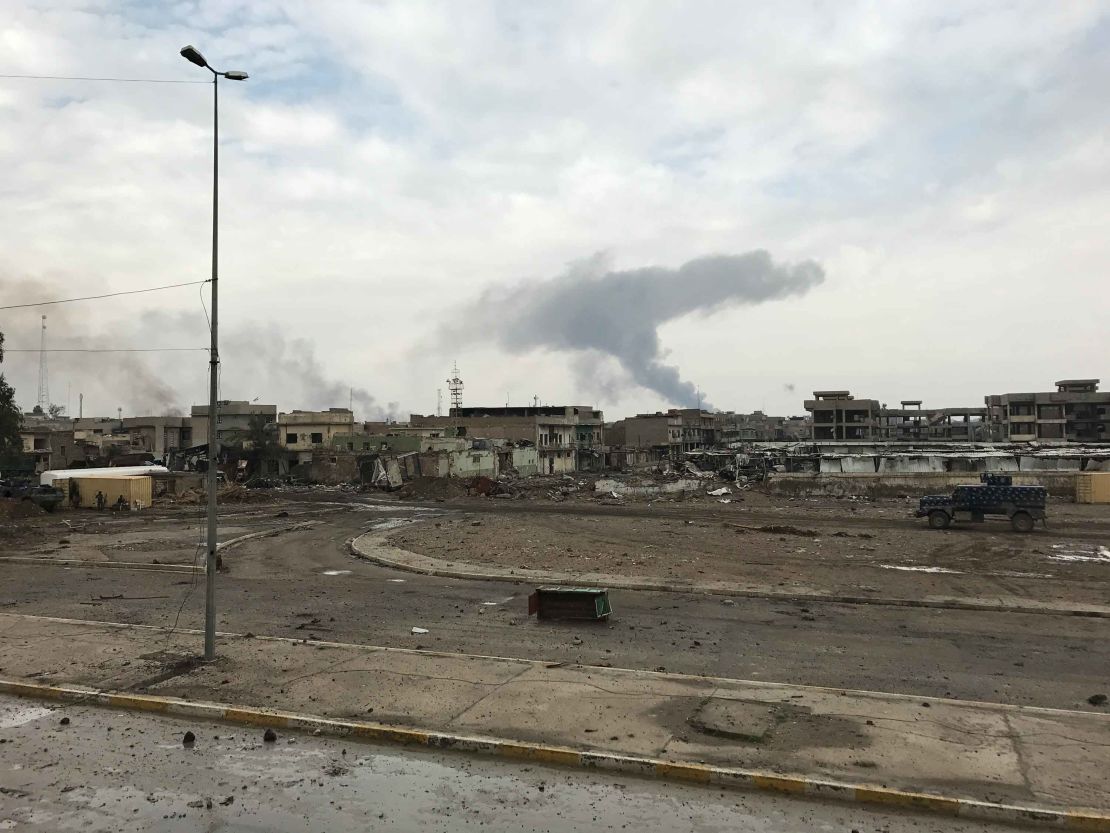
I turned around and saw Sufian again, struggling to push his mother in a wheelchair through the muck.
“A real disaster,” Sufian told me, breathless. “We lost everything: our hearts, our beliefs, our belongings. We don’t belong here any more. We want peace.”
“Will you come back?” I asked.
“No, I can’t,” he said. “No more. I can’t. I’m so scared. They will kill us.”
I stopped to let them go, saying in Arabic “khair, in sha Allah,” which roughly translates as “God willing, all will be well.”
“We have Jesus,” responded Sufian. “We are going to Jesus.”
“What did Sufian say?” interjected his grandfather in Arabic, hobbling on a cane over to me.
I didn’t respond. I couldn’t fathom why someone with the very Sunni Muslim name of Sufian would say that.
Is this what he meant when he had said we lost our beliefs?
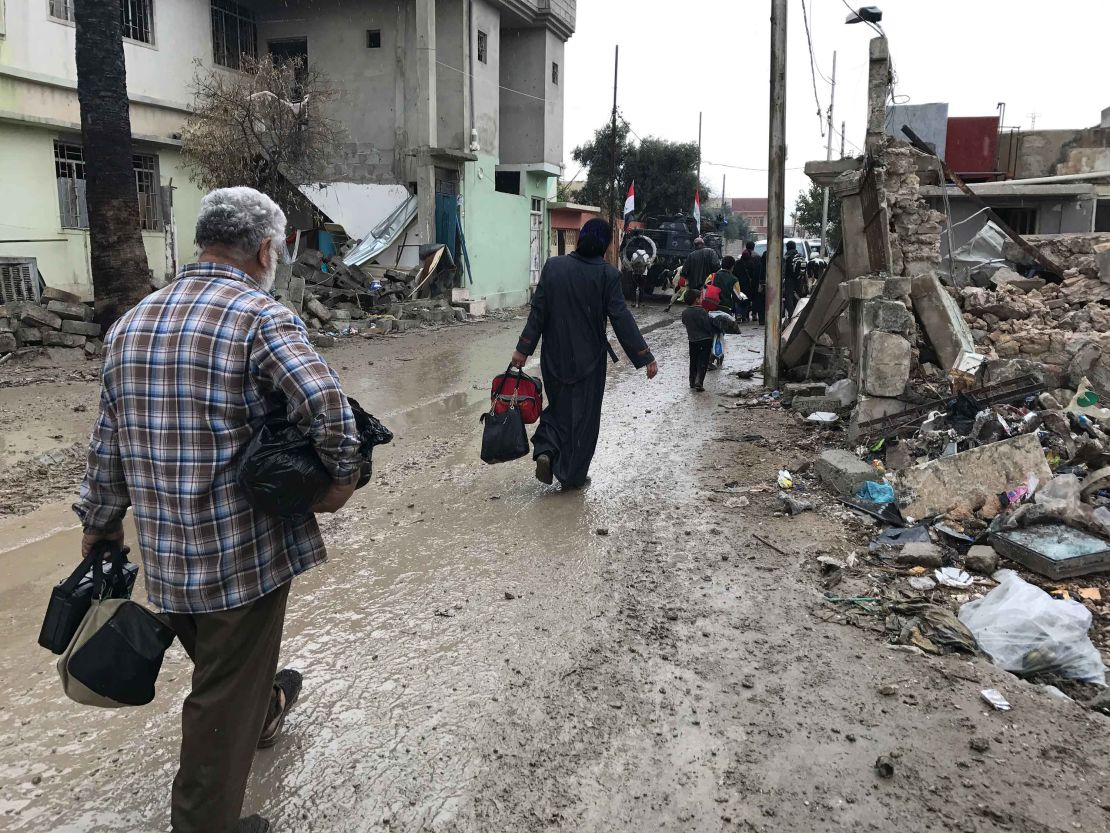
In the meantime, Kareem’s charm bore fruit. The intelligence officers were laughing, asking us to pose for group pictures. They were ready to take us deeper into the city. This would be our second try that day.
Earlier, we had driven with members of the Rapid Response Unit of the Iraqi Federal Police to a park next to the Mosul museum. But as we were driving up, our car shook with a massive blast. The shock wave rattled the shutters on the shops lining the road.
Related: In war-torn western Mosul, a determined few remain
When we exited our car, we saw a cloud of black smoke rising about 150 meters (492 feet) away.
One by one, ambulances were going forward. The soldiers were on edge. A pickup truck rushed by in the opposite direction, several wounded soldiers in the back.
We later learned an armored ISIS suicide earthmover had exploded, killing and wounding many of the soldiers.
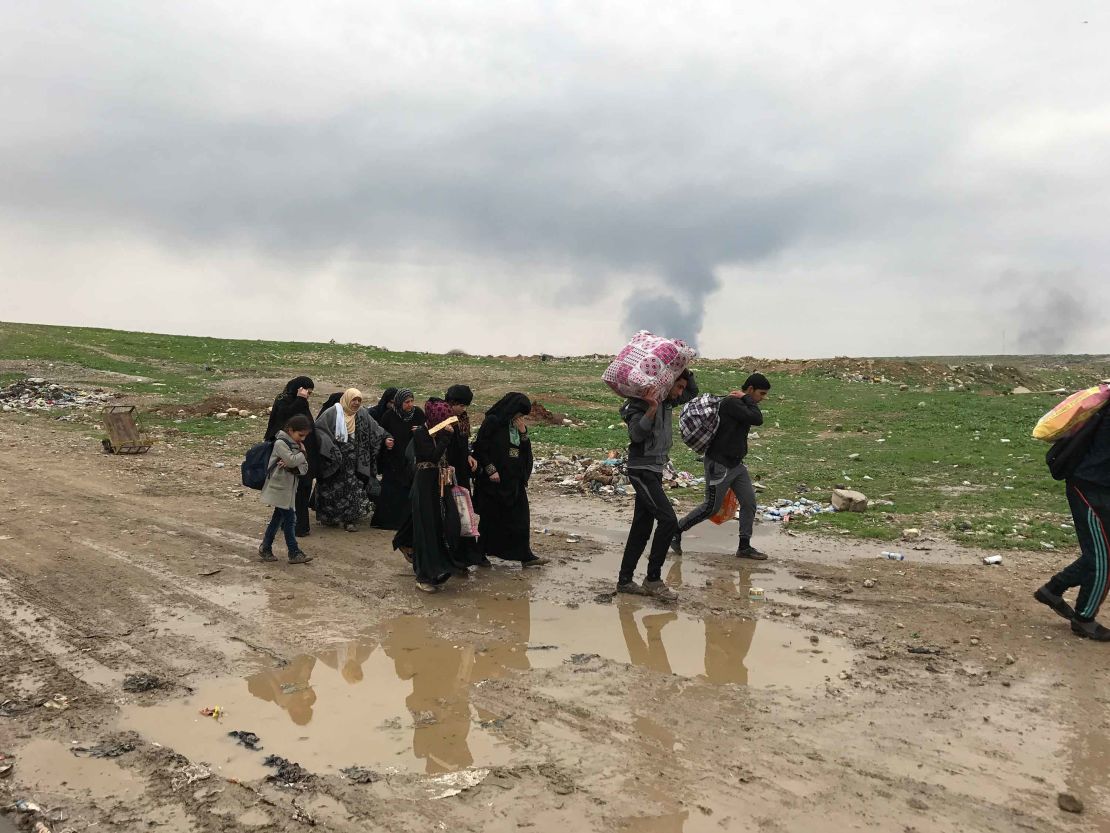
Our escort, a man named Captain Firas, decided we had seen enough. He barked for us and the other journalists to get back in our cars. Protests fell on deaf ears.
We drove back to the ruins of Mosul airport, losing Captain Firas along the way.
There we saw hundreds of Mosul residents walking out of the city. Leading the group was Saleh Jassim, a man in his early thirties, a white calf draped over his shoulders, other cows following him.
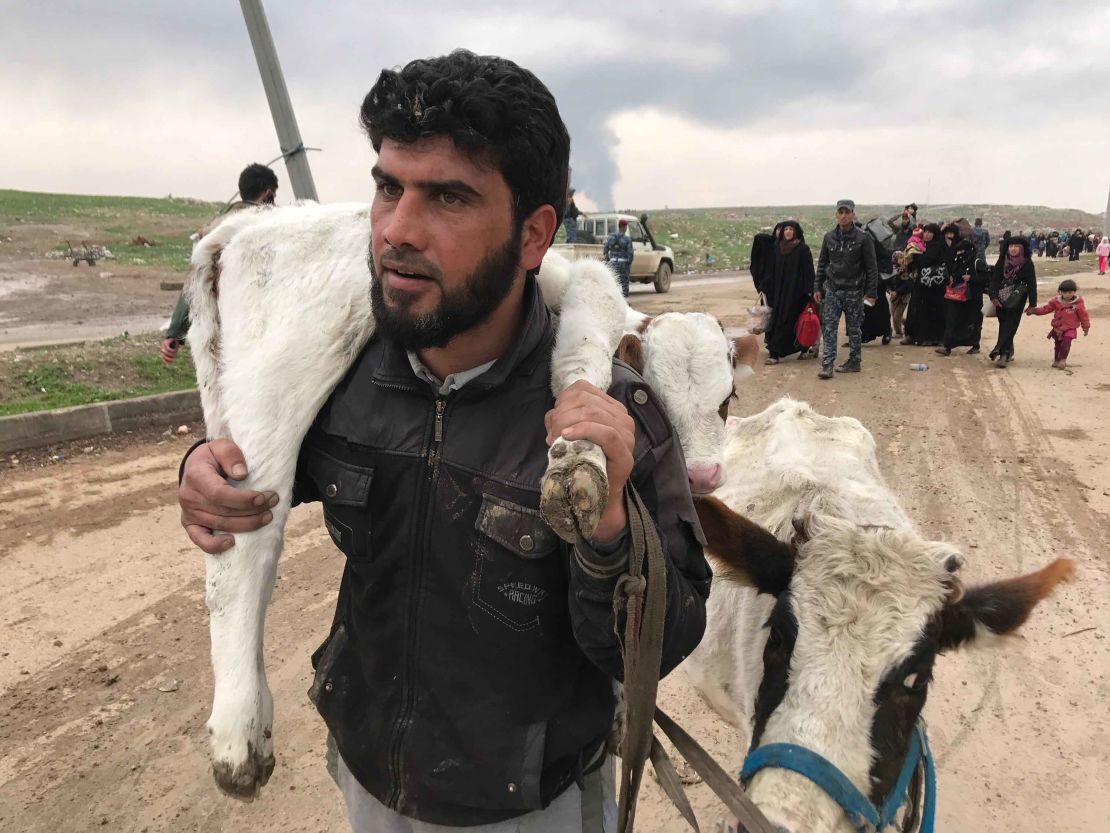
While others appeared exhausted and disoriented, Saleh was smiling broadly, waving, giving a V-for-victory sign with his fingers.
“Thank God for your safety,” I told him in Arabic. In response, he kissed my cheeks.
Saleh and his family had walked for two hours from their home in the Bab Al-Baidh district of Mosul’s old city.
“The shelling was violent,” he told me. “I haven’t slept in two days.”
The cows, he added, belonged to a neighbor.

While Mary and I were talking to Saleh, Kareem had stopped a Federal Police pick up truck and convinced the men inside to take us back into the city. That’s where we met Sufian.
If this story is starting to sound disjointed, that’s how our days in Mosul usually are. Plan A quickly becomes Plan B, then Plan C, until we get half-way through the alphabet.
After speaking with Sufian and his family, we followed our new-found friends, the intelligence officers, deeper into the city by car where they promised to take us to their commander. He wasn’t there. As we waited, seven soldiers came down the street. There were pulling two men with their shirts pulled over their faces.
“They’re da’eshis,” a soldier next to us said. ISIS.
“How do you know they’re ISIS suspects?” I asked one of the intelligence officers.
“They’re not suspects. They are ISIS,” he shot back.
“How do you know?”
“We have informers,” he said.
“I hope you let them have it,” shouted a soldier by the side of the road.
As the group ran past, I saw red marks, and two black boot marks on one of the captive’s exposed back. They had already “let them have it.” Or to be more precise, had started to let them have it.
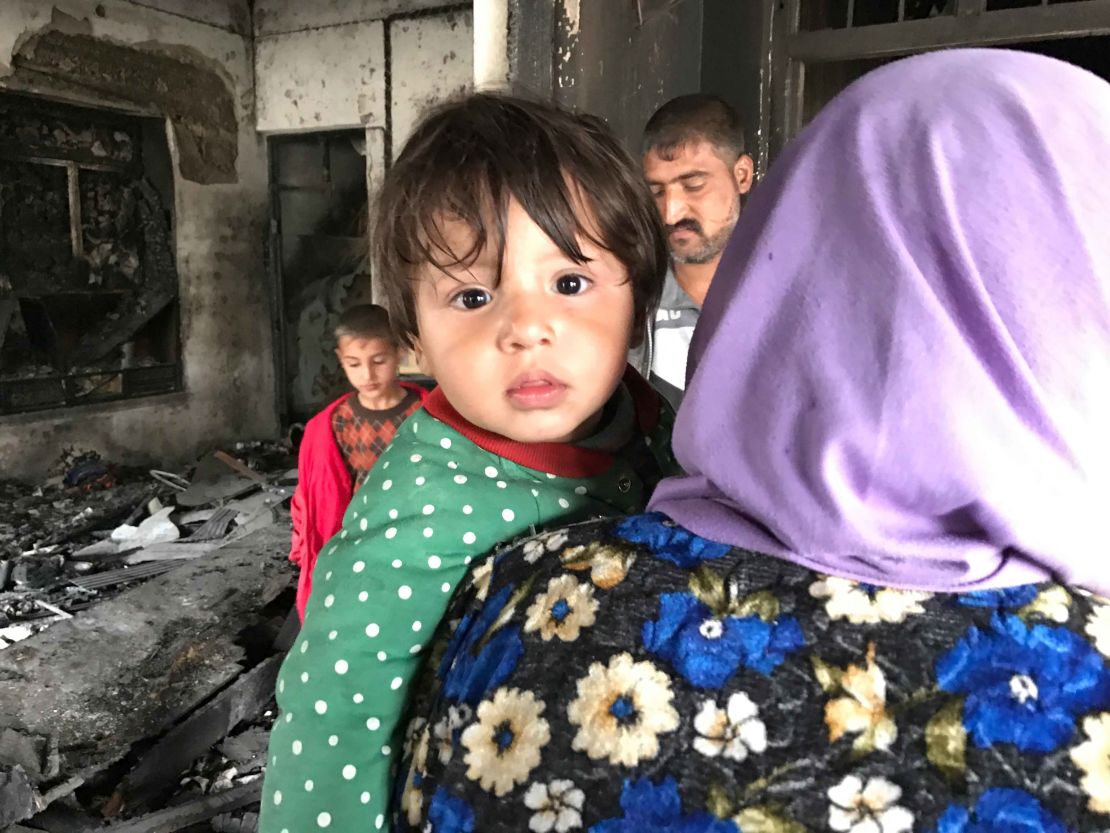
The commander we had come to meet never showed up. Instead, we followed another group of federal policemen into a half-finished building where they said we could see Al-Hadba, the leaning minaret of Mosul next to the Great Mosque of al-Nuri.
It was there that Abu Bakr Al-Baghdadi made his first and only confirmed public appearance on July 4, 2014, days after the announcement of the establishment of his so-called caliphate.
From the third floor of the building, we had a panoramic view of the old city.
“Be careful,” a policeman warned us. “There are snipers.”
Al-Hadba was just about two kilometers, just over a mile away. To its left, a large column of black smoke rose to the heavens. More gunfire, more blasts.
On the broad boulevard below, a family of eight – two boys, four men and two women – scurried by. One of the women, in a green headscarf, clutched a stick with a piece of white cloth to signal they were not combatants.
“Come,” offered one of the soldiers, “I’ll show you a dead da’eshi.”
We followed him down the stairs, though a courtyard, over an earth rampart to the side of a street.
“We have to run across this street, one by one,” he said. “There’s a sniper.”
Once we gathered on the other side of the street, we heard the whoosh of an incoming mortar round.
Everyone hit the dirt.
It landed with a crash somewhere nearby.
Watch: What has become of Baghdadi’s state?
“Quickly, we need to go,” said the soldier. “There might be another mortar.”
Before us was a charred, mangled Federal Police Humvee. Next to it, the burned, twisted wreckage of a car. Probably a car bomb. To its right lay a corpse in combat fatigues and boots, leg splayed. By the stench, it had been there for days.
A black rooster strutted by the body, crowing triumphantly.
All around, there is destruction.
Masonry, glass shards, twisted metal, scraps of clothing, and bullet casings litter the ground.
Machine gun fire rattles down the street.
Another boom.
This is what is left of the great city of Mosul.





